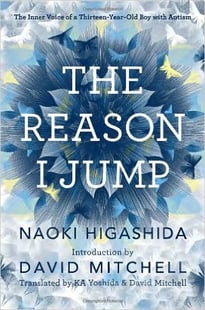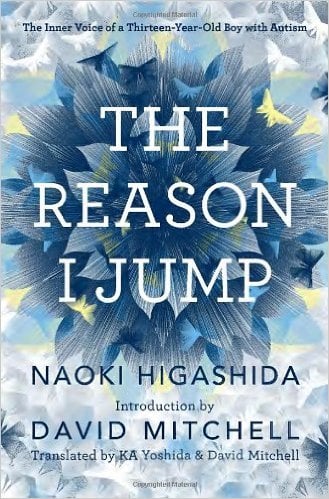Book Review: The Reason I Jump by Naoki Higashida
Whenever I sit down to write a new blog entry, I mentally acknowledge the importance of self-advocacy in the lives of people with autism. It is vital that we tell others how we are feeling and what we are thinking, so that the community can understand our needs. I write these blog entries for similar reasons, and I appreciate the opportunity to tell family members and professionals about my experiences so that they can learn from them. However, I have recently read a book where a 13-year-old boy with autism describes the thought processes and emotions that result in his autistic traits. This book, titled “The Reason I Jump,” is a vital resource for those who are seeking to understand children who are on the lower end of the autism spectrum, and I enjoyed reading it very much.
 The author of this book, Naoki Higashida, is a boy who struggles significantly with verbal communication. He prefers to type his thoughts onto a computer, which he finds to be very useful for helping others understand him. When he recognized his success in this area, Naoki decided to write a book that discussed a variety of challenges that he was facing. This way, the community at large could become more aware of the issues that autistic people struggle with on a daily basis. The writing in this book alternates between a question and answer format (where Naoki answers questions about autistic symptoms and how they affect him) and a short story format (where Naoki tells a fictional story that is symbolic of his life with autism). I found both of these formats to be very easy to read, as the information was in smaller chunks and not in groups of long paragraphs.
The author of this book, Naoki Higashida, is a boy who struggles significantly with verbal communication. He prefers to type his thoughts onto a computer, which he finds to be very useful for helping others understand him. When he recognized his success in this area, Naoki decided to write a book that discussed a variety of challenges that he was facing. This way, the community at large could become more aware of the issues that autistic people struggle with on a daily basis. The writing in this book alternates between a question and answer format (where Naoki answers questions about autistic symptoms and how they affect him) and a short story format (where Naoki tells a fictional story that is symbolic of his life with autism). I found both of these formats to be very easy to read, as the information was in smaller chunks and not in groups of long paragraphs.
I also could tell that Naoki’s thoughts were clearly written, and my own experiences with autism allowed me to see that the adults around him had not tampered with his ideas. However, the translator for this book sometimes uses British expressions in the book (e.g. “I reckon” and “lose the plot completely”), which makes it obvious that he was attempting to recreate Naoki’s language in a way that would be understandable to English-speaking readers. Although this type of recreation may offend some writers, I do not feel that it was disrespectful in nature. Instead, I believe that it was done to make the book more accessible, although I occasionally felt that the language was too “adult” for a 13-year-old’s writing.
That being said, I could definitely relate to the reasons that Naoki gives for autistic people behaving in certain ways. One passage talks about how he jumps around when he is happy and excited emotions reach a sky-high level. Therefore, his jumping serves as a calming mechanism so that he can become more in tune with his surroundings. I have engaged in this self-stimulatory behavior for virtually my entire life, and I know exactly what he is saying. I sometimes become so excited that I need to release my energy somehow, and this level of excitement seems to be stronger than those experienced by neurotypicals. The excitement appears to be overflowing and streaming out of my body, and I jump to make it leave faster so that I can calm down. I admire Naoki for describing this phenomenon in such a sophisticated manner, despite his young age. It is something that many people with autism experience, and something that typical people may not understand unless someone like Naoki describes it to them.
Another passage that I was particularly moved by took place when Naoki was discussing his social anxieties. He was answering a question that is asked to many autistic people, which is why he appears to be withdrawn or aloof during social occasions. He replied that he is not withdrawn at all during these events. Instead, he is afraid of making others uncomfortable and annoyed through his social behaviors, which causes him to retreat. These thoughts and feelings were a constant for me when I became a teenager who was more aware of his surroundings than in the past. I did not want to put myself in a situation where I was teased or yelled at for what I said to my peers, and I knew that I was more likely to be in these situations because of my social deficits. As a result, I would sit back and watch my peers interact and joke around with each other, and I would feel upset with myself that I could not do the same without looking “stupid”. Over time, I became more confident as I familiarized myself with certain peers, but this was after years of isolation and depression. I only hope that Naoki, too, gained the confidence to approach others and make lasting friendships in the years after this book was published.
Overall, I enjoyed reading this book. Naoki provides an insider’s view of Autism Spectrum Disorder that is often not present in the dialogue about this condition. His beliefs about autistic existence are valuable to those who may be recently diagnosed or who may have children with this diagnosis. Naoki also provided ideas that I had not thought about previously on days when I would think about my own challenges. For example, he frequently emphasizes his love of nature in the book, and he says that autistic people enjoy nature because of its providing an opportunity for solitude in a social world. I had not thought about this before, but it makes sense that people who struggle with socialization may be drawn towards an environment where social pressures are close to nonexistent. This is only an example of the new perspectives that I gained from this book, and it shows that even people who live with autism can learn from our brothers and sisters as we make our way through life. I enjoyed reading this book very much, and I wish Naoki Higashida nothing but the absolute best in his future endeavors.

Nathan Hughes
Nathan Hughes is a recent graduate of Lesley University, where he received his Master’s Degree in Education of Students with Moderate Disabilities in Grades 5-12. He is also a graduate of Salem State University, where he received a Bachelor’s Degree in English. As someone who is on the autism spectrum, Nathan’s goal is to work in educational research and to contribute to a better understanding of autism.





